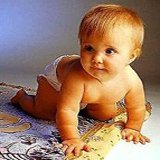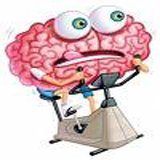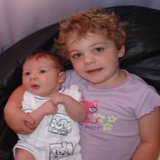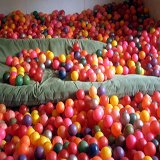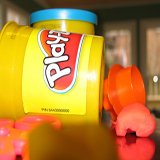Stages of Hand Eye Coordination - Skills & What to Do
All the stages of hand eye coordination involves the control of eye movement and the processing of visual input to guide bodily movement in children.
All stages of hand eye coordination is a way of performing everyday tasks and in its absence most people would be unable to carry out even the simplest of actions such as picking up a book from a table.
Before children can learn to write they need to develop the ability to hold the pencil appropriately and to coordinate vision and fine muscle movement in order to use the pencil.
Of course, the stages of hand eye coordination depends on the age of your child.
Here you'll find different stages of hand eye coordination fine and gross motor skills and what to do to promote hand eye coordination in toddlers (including left handed children).
The different stages of hand eye coordination in children are broken down according to age for easy reference.
Stages of Hand Eye Coordination: 15 - 18 months
| Skill | What to Do |
| Your toddler's hand eye coordination has extended significantly, and he is probably able to hold two items in each hand at the same time. | Place your child in a comfortable, upright sitting position. Take a couple of quite small toys and put them in his left hand. Immediately put another two in his right hand - he'll hold all four is his hands for a few seconds. |
| He sees the connection between his hand movements and the immediate environment and recognizes that he has some control over his actions. | Sit your toddler on the floor with a small towel spread out in front of him so that one corner is near his hand. Put a small toy on the other corner of the towel and ask him to get it - you'll find that he pulls at the corner of the towel nearest to his hand in order to bring the toy towards him. |
| He loves making marks on paper, whether using crayons or paints, and will happily fill sheet after sheet. | Make sure he has easy access to plenty of paper and crayons (the chubby sort that are easy for small hands to grasp) sot hat he can draw whenever he wants. You could also let him do finger painting - this can be a very messy activity but he'll love it. Let him see that you are interested in the results. |
Stages of Hand Eye Coordination: 19 - 21 months
| Skill | What to Do |
| He thoroughly enjoys playing games with balls, both large and small, and attempts to roll them, throw them and even catch them. | Your toddler can be either seated or standing during this activity. Put a medium-sized, light plastic ball in his hands - so that he holds it firmly in front of him - and ask him to throw the ball. He will try to do this although the ball may go in any direction. |
| He is able to stack small wooden blocks on top of each other to make a tall tower without if falling over. | Seat your toddler at a table. Place some small wooden blocks nearby and ask him to make a tower. (Demonstrate this if he is at all unsure) With a little practice, he'll be able to build a tower with five or more bricks before it topples over. |
| Your toddler loves water play and is able to pour water from one container into another one without much spilling. | Give your toddler one empty plastic cup and another half full of water. Ask him to pour the water from the half-full cup into the empty one. He will probably be able to manage this without spilling. |
Stages of Hand Eye Coordination: 22 - 24 months
| Skill | What to Do |
| He takes great pleasure from looking at books with you and will be content to sit for several minutes studying each picture and turning the pages. | Choose a children's book with robust pages that will withstand the rough handling of a young child. Either sit beside your toddler or place him on your lap. Let him hold the book. Then look at the pictures on each page. He'll point to the ones that he recognizes. |
| His increased hand eye coordination makes him want to help get himself dressed and undressed. The more you encourage him, the more adept he'll become. | When bath time approaches, tell your 2-year-old that you would like him to help you with undressing. he won't manage zip fastenings, but he'll probably be able partly to remove some items himself, such as socks and possibly a loose-fitting jumper. |
| He has a well-controlled pincer grip - in other words, he can coordinate index finger and thumb effectively to pick up small objects. | Place a small toy in front of him and ask him to pick it up. Whereas at a younger age he would have tried to sweep it up in the palm of his hand, he now tries to use his thumb and index finger. He does this slowly, and may become agitated if it slips from his grasp. |
Stages of Hand Eye Coordination: 25 - 30 months
| Skill | What to Do |
| Bead-threading is an activity that may attract his interest since it gives him the opportunity to practice his improving hand-eye coordination. | Buy a set of large wooden beads and some laces. (Keep an eye on him while he plays with the beads just in case he thinks it is a good idea to taste them!) Your child will soon master how to thread the lace through the hole. |
| His confidence has grown and he is now able to manage many more tasks that require good hand control, such as painting and drawing. | When given a crayon and paper, you'll notice that he grips the crayon in his hand more maturely. Instead of grasping it in the palm of his hand, he holds it firmly with three or four fingers and has no difficulty making a deliberate mark on the paper. |
| He is able to copy with construction toys and games that involve different pieces that have to be placed together in a specific way before they connect. | Let him play with various types of interlocking plastic bricks - he has endless fun making different shapes. In addition, ask him to build a tower with small wooden blocks. At this age, he can build a steady tower perhaps seven or eight blocks high. |
Stages of Hand Eye Coordination: 31 - 36 months
| Skill | What to Do |
| He begins to be able to cut paper with a pair of scissors, though he may find this difficult. He needs your encouragement - without it he may give up too easily. | Buy a pair of child-safe scissors, with handles for small hands and with protective covers on the edges of the blades to minimize risk of injury. With practice and support, your child will learn to grip the scissors properly and use them to cut through a piece of paper. |
| His pencil control has improved and his drawing is less random. You can usually see what his pictures are supposed to represent. | As well as letting him do free drawing, suggest that he draws certain shapes. For instance, draw a circle on a piece of paper and than ask him to do the same - he tries hard to copy the design, although the ends of the circle might not meet. |
| Your child likes to help you around the house, sometimes simply copying whatever you do and sometimes actually carrying out a practical task for you. | Use his interest in housework to consolidate his hand eye coordination. For example, his hand control is good enough for him to dust a tabletop, to put toys back into the toy box, and even to put cutlery on the table before meals. |
Find It!
Can't remember where you read something specific? Just type in your search term in the box below and your specific topic will be returned to you instantly.





